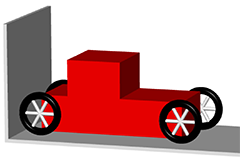group¶

Note
This is a beta release of group. Points, curves, helix and label do not currently work with group. The size attribute of group exists but is meaningless.
A group is a collection of objects. Moving or rotating a group affects all objects in the group. However, objects belonging to a group retain their identities and can be rotated, resized, colored etc. individually. (In contrast, objects used to create a compound lose their individual identities once compounded. Compound is less expensive computationally than group.)
For example, using a group you can create a car whose wheels turn as the entire group moves, as in this example program .
To create a group:
First create the group
Then add objects to the group by specifying the name of the group as the group attribute of each object. Positions of objects in a group are relative to the pos of the group.
- mygroup = group(pos=vec(1,-1,3) )
- Parameters:
pos (vector) – Position of group. Default <0,0,0>. This is not necessarily the center of the collection of objects, nor is it necessarily at one end.
axis (vector) – Default <1,0,0>. Modifying axis changes the orientation of all objects in the group.
color (vector) – Modifying the color of a group changes the color of every object belonging to the group; the original color of a constituent object is lost. Initially the color of a group is set to white although the constituent objects retain their own colors. Assigning any value to color permanently changes the color of all objects in the group.
visible (boolean) – If False, object is not displayed. Default: True
canvas (object) – Default is scene.
make_trail (boolean) – If True, object leaves a trail when moved.
up (vector) – A vector perpendicular to the axis.
mygroup = group(pos=vec(0,0,0))
p1 = pyramid(group=mygroup, pos=vec(1,0,0), color=color.red)
p2 = pyramid(group=mygroup, pos=vec(1,2,0), color=color.yellow)
scene.pause()
mygroup.pos=vec(-3,0,0)
scene.pause()
mygroup.rotate(angle=pi/2, axis=vec(0,0,1))
Methods of group¶
- mygroup.group_to_world(myvec)
Converts a location relative to the group position to a position in world coordinates.
- mygroup.world_to_group(myvec)
Converts a location in world coordinates to a position relative to the pos of a group.
- mygroup.rotate(axis=vec(0, 0, 1), angle=pi / 2)¶
Same as rotation for 3D objects.